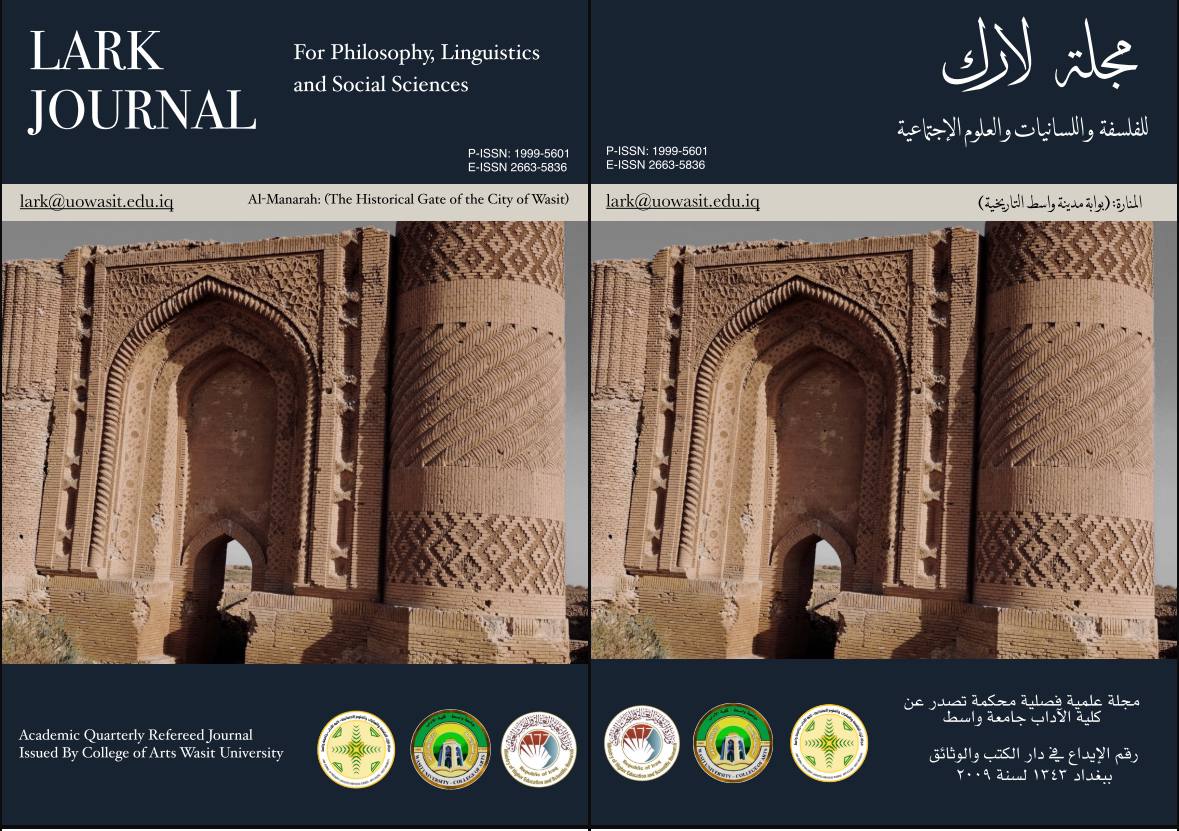The Translator’s Preface as Paratext: A Thematic Study of Translator’s Prefaces in English to Arabic Translations
DOI:
https://doi.org/10.31185/lark.4812Keywords:
Keywords: Paratexts, Translator’s Preface, Thematic Analysis.Abstract
This study explores the translator’s preface as an essential paratextual element in English into Arabic translations. Drawing on Genette’s (1997) paratextual theory and Batchelor’s (2018) emphasis on treating paratexts as ends in themselves, the study conducts a thematic analysis on (50) translator prefaces that were selected randomly to examine both their thematic patterns as well as their functional characteristics. A mixed-methods approach is employed, combining qualitative thematic analysis with quantitative frequency analysis to identify the reoccurring and the most prevalent themes discussed by translators in their prefaces. The study introduces the Wadi & Al-Ali (2025) as a suggested model that could be applied in future studies to evaluate translators’ prefaces in different contexts.
References
Alblooshi, F. K. (2021). The role of paratextual elements in the reception of translation of Arabic novels into English (Doctoral dissertation, Kent State University). OhioLINK Electronic Theses and Dissertations Center. http://rave.ohiolink.edu/etdc/view?acc_num=kent1617719565200925
Ashraf, M. (2020). Paratextual Aspects in the Translation of Nawal Saadawi’s The Innocence of the Devil.
Batchelor, K. (2018). Translation and paratexts. Routledge. https://doi.org/10.4324/9781351110112
Braun, V., & Clarke, V. (2006). Using thematic analysis in psychology. Qualitative Research in Psychology, 3(2), 77–101. https://doi.org/10.1191/1478088706qp063oa
Dimitriu, R. (2009). Translators’ prefaces as documentary sources for translation studies. Perspectives: Studies in Translatology, 17(3), 193-206. https://doi.org/10.1080/09076760903255304
Fayed, S. (2021). Translators’ prefaces to literary works a means to visibility or invisibility? A cda approach to analyze translators’ prefaces as part of the paratext. Cairo Studies in English, 2020(1), 258–279. https://doi.org/10.21608/cse.2021.147203
Forbes, M. B. (2023). "To the General Reader:" How 16th-century paratexts evolved the reader (Publication No. 30485452) [Doctoral dissertation, Fordham University]. ProQuest Dissertations & Theses Global. https://www.proquest.com/openview/ccaa11e388b9d59e55176bc6540f9677/1?pq-origsite=gscholar&cbl=18750&diss=y
Freeth, P. J. (2023). Between consciously crafted and the vastness of context: Collateral paratextuality and its implications for translation studies. Translation Studies, 16(3), 419–435. https://doi.org/10.1080/14781700.2023.2194882
Genette, G. (1997). Paratexts: Thresholds of interpretation (J. E. Lewin, Trans.). Cambridge University Press.
Haroon, H. (2017). The translator’s preface as a paratextual device in Malay-English literary translations. The International Journal of Translation and Interpreting Research, 9(2). https://doi.org/10.12807/ti.109202.2017.a07
McRae, E. (2006). The role of translators’ prefaces to contemporary literary translations into English (Master’s dissertation, University of Auckland).
Nelson, K. (1998). A pretext for writing: Prologues, epilogues, and the notion of paratext. SSRN Electronic Journal. https://doi.org/10.2139/ssrn.1141062
Özbir, U. (2020). Translator’s preface and notes in the Turkish version of Pale Fire: Para-textual interventions of the translator justified? RumeliDE Dil ve Edebiyat Araştırmaları Dergisi, 18, 627–638. https://doi.org/10.29000/rumelide.706428
O’Connor, A. (2022). Women translators and paratextual authority: The frameworks of religious translation. Parallèles, 34, 130–140. https://doi.org/10.17462/para.2022.01.11
Pellatt, V. (Ed.). (2013). Text, extratext, metatext and paratext in translation. Cambridge Scholars Publishing.
Qun-Xing, Z. (2016). Translators’ Voice in Translated Texts. Journal of Literature and Art Studies, February 2016, Vol. 6, No. 2, 178-185 doi: 10.17265/2159-5836/2016.02.007
Rockenberger, A. (2014). Video game framings. In N. Desrochers & D. Apollon (Eds.), Examining paratextual theory and its applications in digital culture (pp. 252–286). IGI Global. https://doi.org/10.4018/978-1-4666-6002-1.ch013
Shakir, M.F. and Al-Ali, K. K (2021). Post-Editing as a Creative Tool in Improving the Quality of the Product of Translation Students. Journal of the College of Arts, University of Basrah. No. (97). V1. https://www.basradab.edu.iq/wp-content/uploads/2024/09/14_Post_Editing_as_a_Creative_Tool_in_Improving_the_Quality_of_the.pdf
Stokem, R. (2020). “This is a true story”: Paratextual prefaces and their fictive truths across literature (Master's thesis). Seton Hall University. Retrieved from https://scholarship.shu.edu/dissertations/2766
Tekten, B. (2019). A comparative study on the paratextual elements in the translations of Edgar Allan Poe’s short story compilations (Master’s thesis, Hacettepe University). Hacettepe University Graduate School of Social Sciences.
Terenas, G. G. (2023). Paratexts as mediators of translations. The case of the preface to a Portuguese version of Defoe’s Robinson Crusoe. Diacrítica, 37(3), 174–185. https://doi.org/10.21814/diacritica.4851
Toledano-Buendía, M. C. (2013). Listening to the voice of the translator: A description of translator’s notes as paratextual elements. The International Journal of Translation and Interpreting Research, 5(2). https://doi.org/10.12807/ti.105202.2013.a09
Venuti, L. (1995). The translator’s invisibility: A history of translation. Routledge.
Yalsharzeh, R., Barati, H., & Hesabi, A. (2019). Dissenting voices: When paratexts clash with texts. Paratextual intervention in persian translations of texts relating to the iran-iraq war. Meta, 64(1), 103–124. https://doi.org/10.7202/1065330ar
Yari, A., & Amirian, Z. (2022). Gender and paratextual visibility: A case study of Iranian fiction translators. Journal of Language Horizons, 6(3), 49–63. https://doi.org/10.22051/lghor.2021.34800.1434
Downloads
Published
Issue
Section
License
Copyright (c) 2025 أ. د. كاظم خلف العلي، الباحثة: رغد سعدون وادي

This work is licensed under a Creative Commons Attribution 4.0 International License.





